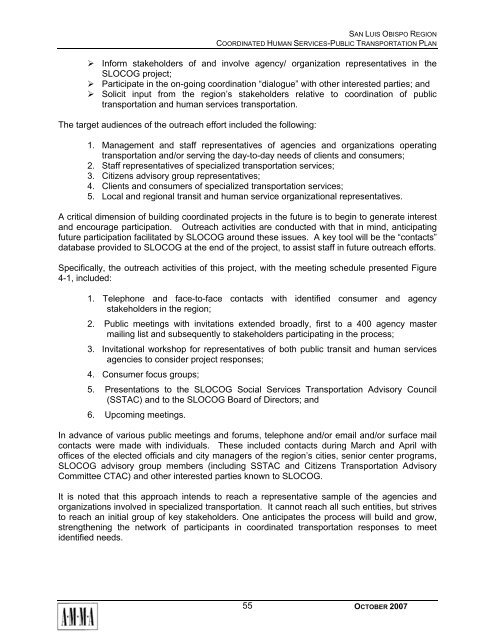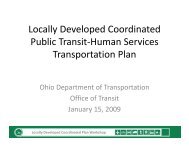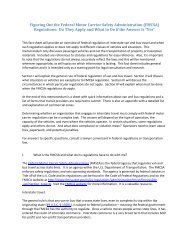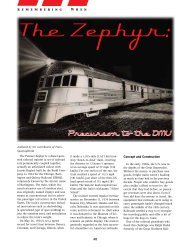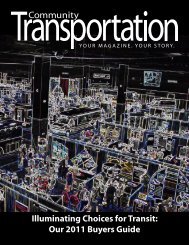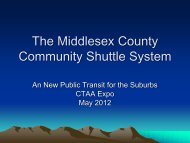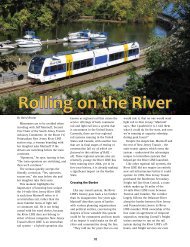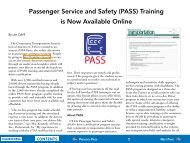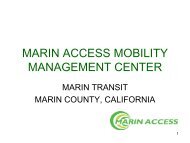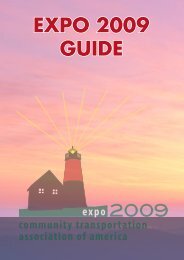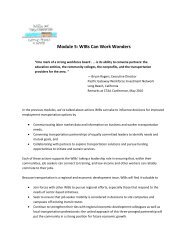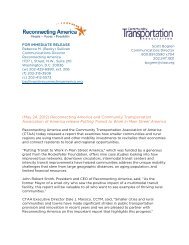San Luis Obispo - Caltrans - State of California
San Luis Obispo - Caltrans - State of California
San Luis Obispo - Caltrans - State of California
Create successful ePaper yourself
Turn your PDF publications into a flip-book with our unique Google optimized e-Paper software.
SAN LUIS OBISPO REGION<br />
COORDINATED HUMAN SERVICES-PUBLIC TRANSPORTATION PLAN<br />
‣ Inform stakeholders <strong>of</strong> and involve agency/ organization representatives in the<br />
SLOCOG project;<br />
‣ Participate in the on-going coordination “dialogue” with other interested parties; and<br />
‣ Solicit input from the region’s stakeholders relative to coordination <strong>of</strong> public<br />
transportation and human services transportation.<br />
The target audiences <strong>of</strong> the outreach effort included the following:<br />
1. Management and staff representatives <strong>of</strong> agencies and organizations operating<br />
transportation and/or serving the day-to-day needs <strong>of</strong> clients and consumers;<br />
2. Staff representatives <strong>of</strong> specialized transportation services;<br />
3. Citizens advisory group representatives;<br />
4. Clients and consumers <strong>of</strong> specialized transportation services;<br />
5. Local and regional transit and human service organizational representatives.<br />
A critical dimension <strong>of</strong> building coordinated projects in the future is to begin to generate interest<br />
and encourage participation. Outreach activities are conducted with that in mind, anticipating<br />
future participation facilitated by SLOCOG around these issues. A key tool will be the “contacts”<br />
database provided to SLOCOG at the end <strong>of</strong> the project, to assist staff in future outreach efforts.<br />
Specifically, the outreach activities <strong>of</strong> this project, with the meeting schedule presented Figure<br />
4-1, included:<br />
1. Telephone and face-to-face contacts with identified consumer and agency<br />
stakeholders in the region;<br />
2. Public meetings with invitations extended broadly, first to a 400 agency master<br />
mailing list and subsequently to stakeholders participating in the process;<br />
3. Invitational workshop for representatives <strong>of</strong> both public transit and human services<br />
agencies to consider project responses;<br />
4. Consumer focus groups;<br />
5. Presentations to the SLOCOG Social Services Transportation Advisory Council<br />
(SSTAC) and to the SLOCOG Board <strong>of</strong> Directors; and<br />
6. Upcoming meetings.<br />
In advance <strong>of</strong> various public meetings and forums, telephone and/or email and/or surface mail<br />
contacts were made with individuals. These included contacts during March and April with<br />
<strong>of</strong>fices <strong>of</strong> the elected <strong>of</strong>ficials and city managers <strong>of</strong> the region’s cities, senior center programs,<br />
SLOCOG advisory group members (including SSTAC and Citizens Transportation Advisory<br />
Committee CTAC) and other interested parties known to SLOCOG.<br />
It is noted that this approach intends to reach a representative sample <strong>of</strong> the agencies and<br />
organizations involved in specialized transportation. It cannot reach all such entities, but strives<br />
to reach an initial group <strong>of</strong> key stakeholders. One anticipates the process will build and grow,<br />
strengthening the network <strong>of</strong> participants in coordinated transportation responses to meet<br />
identified needs.<br />
55<br />
OCTOBER 2007


